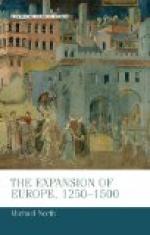Then, suddenly, came the great era of explorations, which were made possible by the improvements in navigation worked out during the fifteenth century, and which in two generations incredibly transformed the aspect of the world. The marvellous character of this revelation can perhaps be illustrated by the comparison of two maps, that of Behaim, published in 1492, and that of Schoener, published in 1523. Apart from its adoption of the theory that the earth was globular, not round and flat, Behaim’s map shows little advance upon Fra Mauro, except that it gives a clearer idea of the shape of Africa, due to the earlier explorations of the Portuguese. But Schoener’s map shows that the broad outlines of the distribution of the land-masses of both hemispheres were already in 1523 pretty clearly understood. This astonishing advance was due to the daring and enterprise of the Portuguese explorers, Diaz, Da Gama, Cabral, and of the adventurers in the service of Spain, Columbus, Balboa, Vespucci, and—greatest of them all—Magellan.
These astonishing discoveries placed for a time the destinies of the outer world in the hands of Spain and Portugal, and the first period of European imperialism is the period of Iberian monopoly, extending to 1588. A Papal award in 1493 confirmed the division of the non-European world between the two powers, by a judgment which the orthodox were bound to accept, and did accept for two generations. All the oceans, except the North Atlantic, were closed to the navigators of other nations; and these two peoples were given, for a century, the opportunity of showing in what guise they would introduce the civilisation of Europe to the rest of the globe. Pioneers as they were in the work of imperial development, it is not surprising that they should have made great blunders; and in the end their foreign dominions weakened rather than strengthened the home countries, and contributed to drag them down from the high place which they had taken among the nations.




